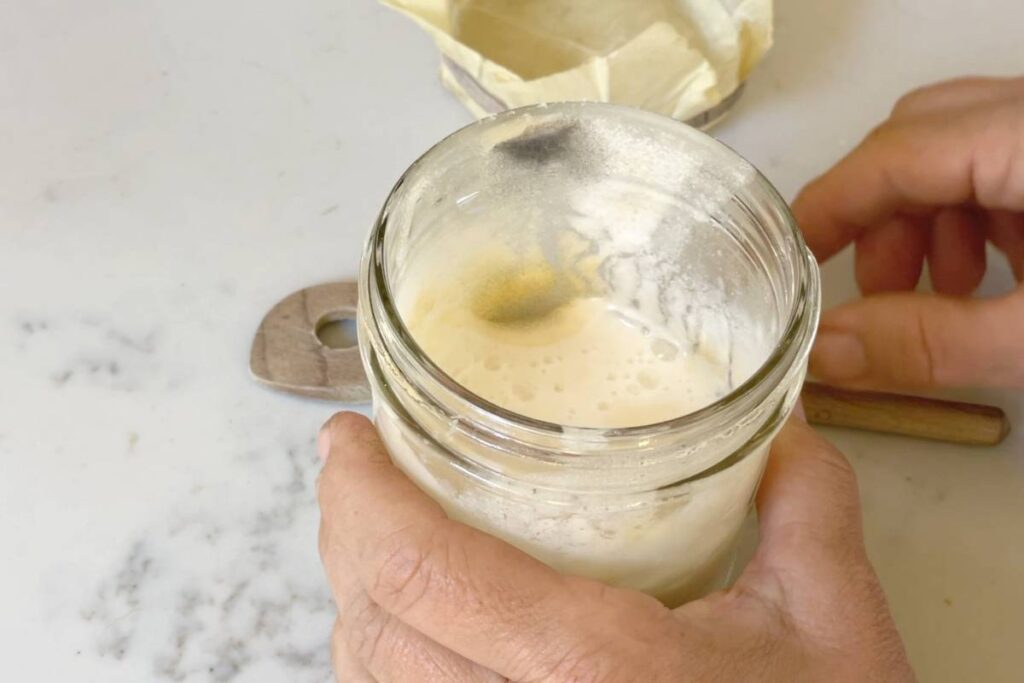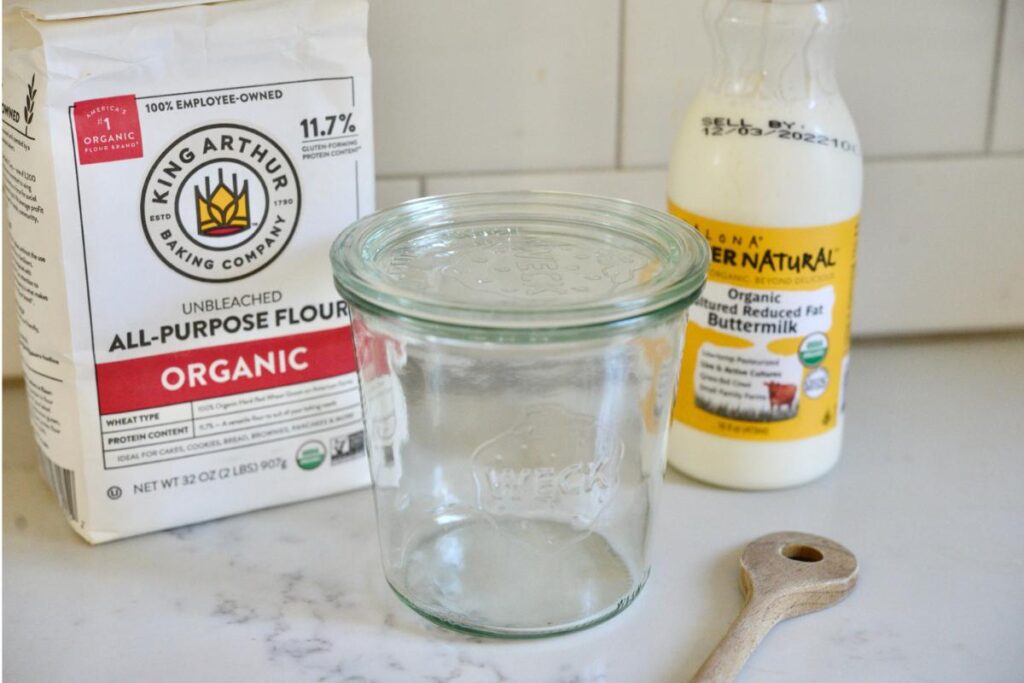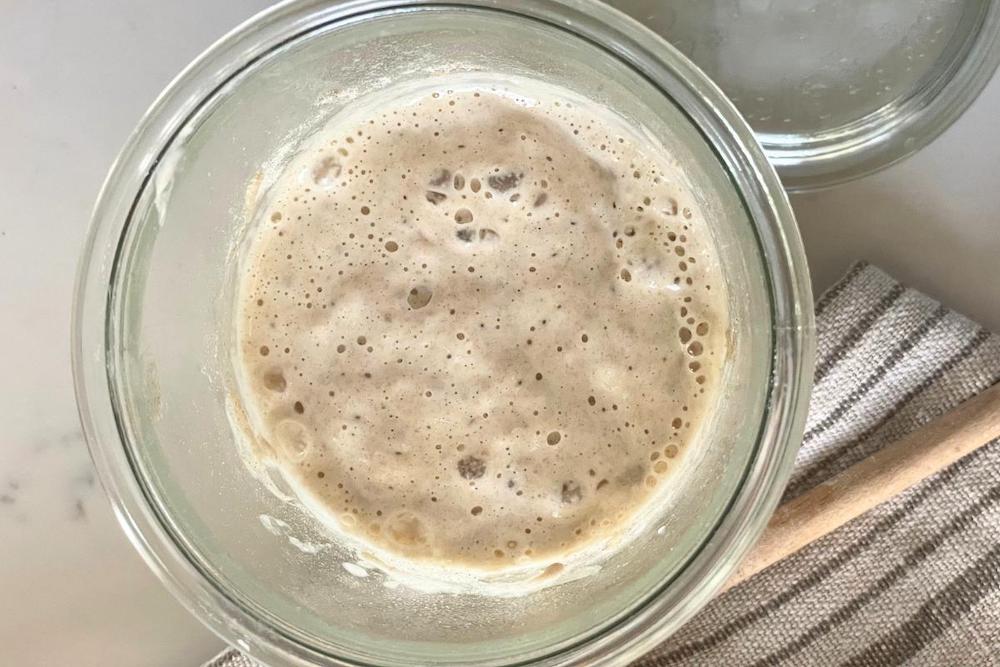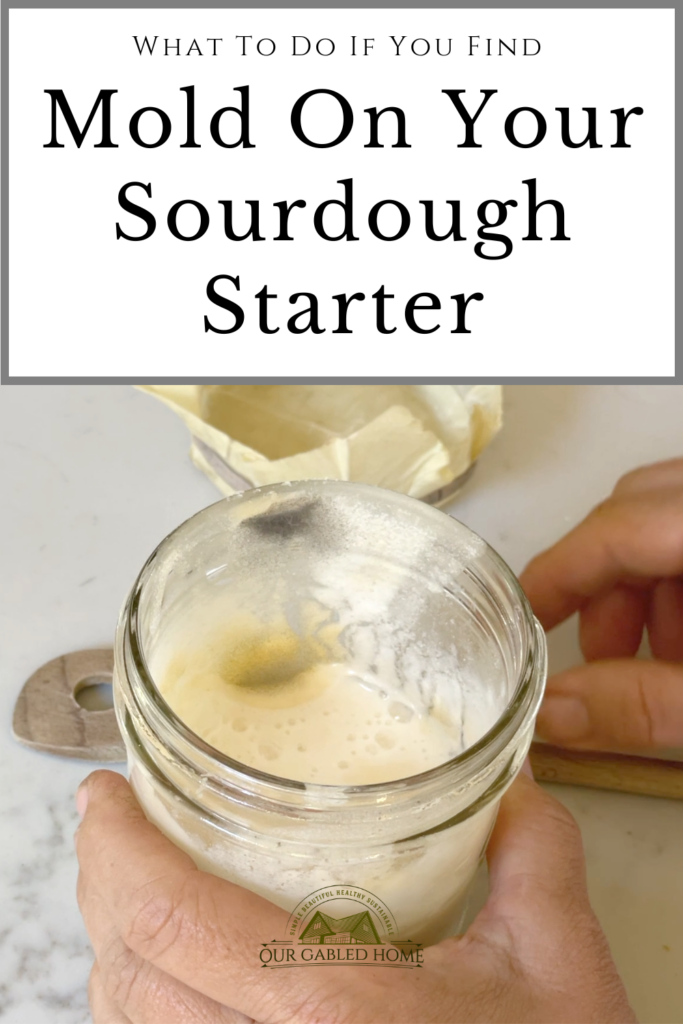Mold on Your Sourdough Starter? Check out These Causes
Learn why mold on your sourdough starter can occur, how to prevent it, and effective ways to revive your starter.
Did you find mold on your sourdough starter?
I know that that is not a pretty sight and can be frustrating!
In this article, I will share the main causes of a moldy sourdough starter which is likely to happen more on a new starter than an established one.
Some of these causes may be obvious but others may completely surprise you. The good news is that understanding the various reasons will help you eliminate them. And get your nice active starter back!
If you don’t one yet, you can read this article on how to make your own sourdough starter.
What are the main reasons for mold on sourdough starters?
Most causes of mold come from:
- The ingredients
- The tools
- Water
- Improper storage
- The environment
What does mold look like?
Most likely, you will know if you have mold on your starter or not. It is often black and fuzzy growth on the side of the jar or on top of your starter. Bad bacteria can also appear as an orange tinge or pink streaks.
However, if you see a brown liquid sitting on top of your sourdough starter that is called “hooch”. It is not dangerous but is often a sign that your starter is hungry. Some people recommend pouring it off. I usually stir it back in and feed it with some extra flour.
Kahm yeast is something else you might find on your starter but it is not really a kind of mold. It often looks white and powdery. It is a sign of yeast over-growth and is harmless.

Contaminated Ingredients
There are 3 ways ingredients can cause mold on your sourdough starter:
- Your flour might contain mold spores. It could be that the flour is old or was stored in a damp environment. Solution: try a new or fresh flour
- The other reason can be bleached flour or conventional flour. Bleaching flour can kill the wild yeasts and good bacteria that are on the grains that we are trying to cultivate. If you are using conventional flour, the grains have likely been sprayed with synthetic pesticides and herbicides that can also kill the natural yeast. Solution: try using at least unbleached flour but better yet organic flour.
The Tools
It is very important to use clean tools and equipment. By clean, I don’t mean bleached or sterilized necessarily. However, soap residue on the jar for your starter can cause mold.
Solution: be sure to use a new or clean jar.
People often worry about using metal utensils. This will not create mold! Especially if you’re only using a metal fork or spoon to stir your sourdough starter.

The Water
The type of water you are using can also cause a mouldy sourdough starter. City water often contains chlorine which will inhibit the growth of a good sourdough culture, especially if you have a very new sourdough starter. It makes sense because municipalities add chlorine to kill microorganisms – and that can kill the good bacteria in your starter as well.
Although rare in the US, the water could also be contaminated with something.
Solution: use filtered or bottled water. If you only have tap water available, you can leave it standing in an open container at room temperature for at least 24 hours and the chlorine will evaporate. Alternatively, you can boil it for 15 minutes.
Improper Storage
If you are keeping your sourdough starter on the counter for regular feedings, it will do best in a warm environment. If you are following my no discard, no feeding sourdough maintenance method, you will keep it in the refrigerator for the most part. Even a healthy sourdough starter can grow mold if you keep it at high humidity. Also, any heat above 140˚F will most likely kill the wild yeast in your starter which will happen in a hot oven. If you keep your sourdough starter in the oven with the light on, be sure to take it out before your turn on the oven.
Solution: make sure to keep your sourdough starter at about 70-85˚F. This nifty device keeps your sourdough starter at the optimal temperature.
The Environment
This is something that people don’t talk about often. However, there are a few ways in which the environment can cause your sourdough starter to go bad:
- Mold spores from moldy fruit can jump over to your sourdough starter and cause mold growth. If you keep fruit or vegetables next to your sourdough starter or in the bread dough, and they have mold on them, the mold spores can easily spread to the starter and start growing there. Solution: make sure to keep your sourdough starter away from anything moldy or even other ferments (such as homemade sauerkraut or kefir).
- An over-sanitized home can also potentially harm the beneficial bacteria and yeasts in a sourdough starter. While cleanliness and good hygiene practices are important for preventing the growth of harmful bacteria, excessive use of sanitizers and disinfectants can create an environment that is too sterile and can kill off beneficial microorganisms. Solution: only use sanitizers, disinfectants, bleach, and so on if absolutely necessary. More info: read the CDC’s guidelines for cleaning your home.
- Your hands. As Vanessa Kimbell says in her book ” Sourdough School” (https://amzn.to/3N31NDP): “I believe, however, that there is another influence in determining which microbes end up in starters. The cultures are nurtured by human hands, and I think that this interdependent relationship with the baker is the missing part of our understanding of where the microbes come from. In other words, the lactic acid bacteria in each baker’s pot might well be influenced by the lactic acid bacteria from the baker’s own skin microflora.” Solution: avoid over-sanitizing your hands. More info: read the CDC’s guidelines on washing your hands.

What do you do if you have mold on your sourdough starter?
If there is any visible mold on your sourdough starter you can never go wrong by throwing it out and creating a new sourdough starter.
However, if there is only a tiny bit of mold on the side of the starter jar, you could scrape that off generously. Then you take a small amount of that starter, transfer it to a new jar and give it a little extra attention in the form of feedings with flour and water. Ultimately, you should go with what you are comfortable with.
Again, if in doubt, just throw out the bad sourdough starter entirely.
What about an unpleasant smell?
You might be worried if your sourdough starter smells like nail polish remover, but most likely, it has not gone bad.
I have actually experienced that after I had kept it in the refrigerator for a long time (more than six months; you can learn more about my sourdough maintenance method). Usually, that is a sign of over-fermentation which produce high levels of acetone. Solution: take a small amount of that old starter and feed it with equal parts of flour and water. You may have to do some additional feedings for a few days until you have a nice, active sourdough starter again.
What Will Not Cause Your Sourdough Starter To Go Bad:
Despite what you may have heard, these things will not kill your sourdough starter:
- using metal utensils (see above)
- mild neglect (just resume your regular feedings)
- incorrect feeding (if you’re not feeding enough, you might get “hooch” and if you are feeding too much flour it might get too dry and not rise as much)
- freezing your sourdough starter (if you’d like to keep your starter long-term I recommend dehydrating it; if you only freeze it for a short time, it won’t kill it but the longer you freeze it the more inactive it might get)

How to Prevent Mold in First Place:
Here are the best practices for preventing mold on your sourdough starter:
- Start with a clean jar.
- Use organic, unbleached all-purpose flour. A better option is whole wheat flour and the best option is rye flour.
- Keep it at 70-75˚F. Either follow a discard-and-feed method according to the instructions or use my super easy method to make a sourdough starter. If you are making a starter for the first time, it might be your most challenging one to make.
- Keep the sourdough starter in a clean but not overly sterilized environment. Be sure to keep it away from your other ferments and anything moldy.
Other Articles You Might Be Interested In:
The Easiest Way To Make A Sourdough Starter
No-Discards, No-Feeding Sourdough Maintenance
Easy No-Knead Sourdough Bread
What to Do With Stale Sourdough Bread
Pin It For Later:


I’ve tried to make 2 starters now. The first was going great and then I spilled 3/4 of it on Day 3 or 4. I tried to continue with the rest but it ended up with a white, powdery looking “crust”. I was afraid that what I was seeing as powdery, might, in fact to be “fuzz”and so I threw it out. The second starter did exactly the same thing on day five. How do I know if I have Kahm yeast or mold?
Interesting! Sandor Katz, author of “The Art of Fermentation,” describes Kahm yeast as a harmless creamy-white-to-beige wavy growth that forms on the surface of fermented vegetables or beverages where oxygen meets the liquid. This film stays at the top, is not fuzzy, and doesn’t grow below the surface. Use your best judgement but I would just scrape it off and see how the starter develops ~ Anja
I have what I think is mold, but you mentioned Kham yeast?
Is this a problem or something to stir into the starter and keep going?
Please provide more info on Kham yeast.
TIA
New SD Starterer
Jacqueline
Kahm yeast is harmful overgrowth of yeast. You can scrape it off ~ Anja
I woke up today to mold in my starter. I was devastated! My starter was probably not healthy the past 4-6 weeks as it had a lot of water on top and didn’t seem to bubble up like it used to. I tossed it out and am sanitizing the vessel and my friend is bringing me some of her starter she froze.
I suspect two possible scenarios
#1 I wasn’t feeding it properly
#2 my flour could have been contaminated
Those could be the reasons. If you make a new one, feed it properly and use a different batch of flour, you will quickly know ~ Anja
I have a question regarding mold – what happened to me was that i had my starter in two different jars in the fridge (same starter and everything, I was planning on using one in a discard recipe and the other as my regular starter) and just one of the jars got moldy. Do you know why this could be? It contained the same starter, flour and everything and both were kept in glas jars in the fridge.
Thanks!
-Liz 🙂
That is very interesting – and hard to diagnose. Good thing you had 2 jars, though ~ Anja
I just started this sourdough journey and I have to say I feel kind of like Job but I am NOT GIVING UP!! I developed mold on the inside of the jar around the rim…wiped it off and kept going. I’ve been repeating your words in my head…paraphrasing “don’t be afraid, don’t give up”! My starter has been behaving wonderfully…. made my first loaves of bread yesterday….my kitchen aid mixer stripped the gears and burned up halfway through kneading my dough. No problem…I finished by hand. It rose beautifully and I divided it and put into loaf pans and it rose the 2nd time beautifully! Finished baking at 2 am! Beautiful! Next morning got halfway through slicing it and my electric knife burned out! The bread is a little denser than I hoped it would be but the flavor is great. Overall, for my first time making sourdough I’m pleased…..cant wait to make more….AFTER I replace my mixer!! Thanks for all your guidance and tips!!!
Yay! That makes me so happy to hear and good for you for not giving up. EVER! You got this and happy sourdoughing ~ Anja
I thoroughly enjoy your articles. I’m on day 9 of my starter using your no discard method and it’s looking good! On day 7 when I looked in on it I had mold on the upper edge & hooch. Right or wrong I wiped out the mold and stirred in flour. I haven’t notice anymore mold and good bubbles even on sides but, I think I’ll take your advice and take some to a new clean jar.(but I think I’ll continue my old, keeping it away from new). Thank you it’s been a very gratifying experience – onto bread!
Nice! I think your starter should be good and I am so happy to hear you’re loving your sourdough journey ~ Anja
Would mold look white??? The entire top of my states looks white and the bottom regular brown rye flour.
That’s hard to diagnose remotely and if in doubt, discard it. However, often white stuff can be Kahm yeast.
I really enjoy your videos on sourdough bread making. I recently put together a starter using your buttermilk method. After the 4th day it began to produce mold. I was so disappointed! But I read your article on mold, and I’m ready to give it another try.
Mold can be frustrating but be sure to go through the list of potential causes – and do not give up! Once you have a mature starter, it will be much less susceptible to mold ~ Anja
Interesting facts here! I have been doing sourdough for 3 years and learned something new! Thanks for sharing!
That makes me so happy to hear ~ Anja
Thank you for this! I haven’t done sourdough in a while but was thinking of starting up again and this post will help me get it going!
Nice! Happy sourdoughing ~ Anja
Anna, this article is so helpful to me right now because I’ve been thinking of getting on the sourdough starter “train” but am still clueless. This info is really good to have. Thank you!
I am so glad to hear that ~ Anja
This is so helpful and thorough, thank you!! I now have a name for that white stuff 😅 and I think I know why a couple of my starters molded.
Yay! I am so glad you found this helpful ~ Anja